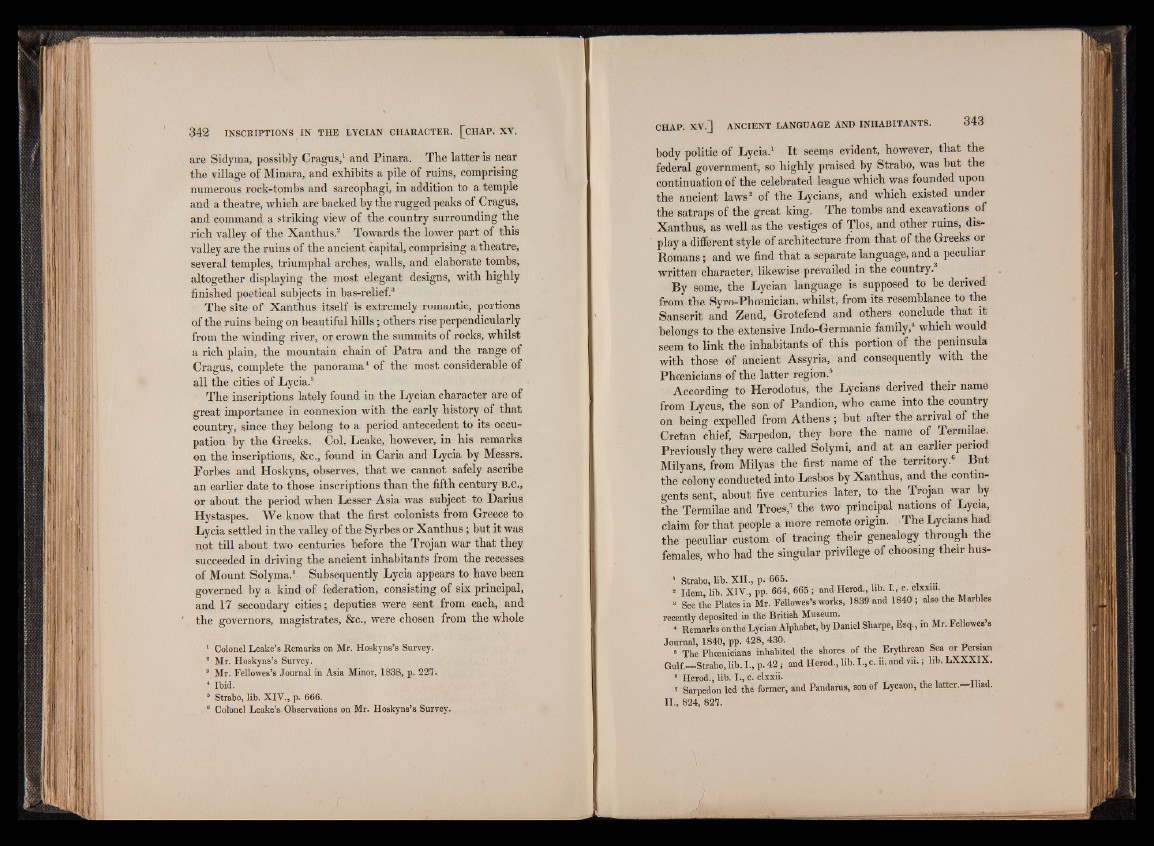
are Sidyma, possibly Cragus,1 and Pinara. The latter is near
the village of Minara, and exhibits a pile of ruins, comprising
numerous rock-tombs and sarcophagi, in addition to a temple
and a theatre, which are backed by the rugged peaks of Cragus,
and command a striking view of the country surrounding the
rich valley of the Xanthus.2 Towards the lower part of this
valley are the ruins of the ancient capital, comprising a theatre,
several temples, triumphal arches, walls, and elaborate tombs,
altogether displaying the most elegant designs, with highly
finished poetical subjects in bas-relief.3
The site of Xanthus itself is extremely romantic, portions
of the ruins being on beautiful hills; others rise perpendicularly
from the winding river, or crown the summits of rocks, whilst
a rich plain, the mountain chain of Patra and the range of
Cragus, complete the panorama'4 of the most considerable of
all the cities of Lycia.5
The inscriptions lately found in the Lycian character are of
great importance in connexion with the early history of that
country, since they belong to a period antecedent to its occupation
by the Greeks. Col. Leake, however, in his remarks
on the inscriptions, &c., found in Caria and Lycia by Messrs.
Forbes and Hoskyns, observes, that we cannot safely ascribe
an earlier date to those inscriptions than the fifth century B.C .,
or about the period when Lesser Asia was subject to Darius
Hystaspes. We know that the first colonists from Greece to>
Lycia settled in the valley of the Syrbes or Xanthus; but it was
not till about two centuries before the Trojan war that they
succeeded in driving the ancient inhabitants from the recesses
of Mount Solyma,6 Subsequently Lycia appears to have been
governed by a kind of federation, consisting of six principal,
and 17 secondary cities; deputies were sent from each, and
the governors, magistrates, &c., were chosen from the whole
1 Colonel Leake’s Remarks on Mr. Hoskyns’s Survey.
8 Mr. Hoskyns’s Survey.
8 Mr. Fellowes’s Journal in Asia Minor, 1838, p. 221.
4 Ibid.
s Strabo, lib. XIV., p. 666.
6 Colonel Leake’s Observations on Mr. Hoskyns’s Survey.
body politic of Lycia.1 It seems evident, however, that the
federal government, so highly praised by Strabo, was but the
continuation of the celebrated league which was founded upon
the ancient laws8 of the Lycians, and which existed under
the satraps of the great king. The tombs and excavations of
Xanthus, as well as the vestiges of Tlos, and other ruins, display
a different style of architecture from that of the Greeks or
Romans; and we find that a separate language, and a peculiar
written character, likewise prevailed in the country.
By some, the Lycian language is supposed to be derived
from the Syro-Phcenician, whilst, from its resemblance to the
Sanscrit and Zend, Grotefend and others conclude that it
belongs to the extensive Indo-Germanic family,4 which would
seem to link the inhabitants of this portion of the peninsula
with those of ancient Assyria, and consequently with the
Phoenicians of the latter region.5
According to Herodotus, the Lycians derived their name
from Lycus, the son of Pandion, who came into the country
on being expelled from Athens ; but after the arrival of the
Cretan chief, Sarpedon, they bore the name of Termilae.
Previously they were called Solymi, and at an earlier period
Milyans, from Milyas the first name of the territory.6 But
the colony conducted into Lesbos by Xanthus, and the contingents
sent, about five centuries later, to the Trojan war by
the Termilae and Troes,’ the two principal nations of Lycia,
claim for that people a more remote origin. The Lycians had
the peculiar custom of tracing their genealogy through the
females, who had the singular privilege of choosing their hus-
1 Strabo, lib. XII., p. 665. ...
8 Idem, lib. XIV., pp. 664, 6 6 5 ; and Herod., lib. I J e. clxxm.
* See tbe Plates in Mr. Fellowes’s works, 1839 and 1 8 4 0 ; also the Marbles
recently deposited in the British Museum. .
4 Remarks onthe Lycian Alphabet, by Daniel Sharpe, Esq., m Mr. Fellowes s
Journal, 1840, pp. 4 2 8 ,4 3 0 . _ n _
5 The Phoenicians inhabited the shores of the Erythrean Sea or Persian
G u lf -S t r a b o ,lib .I .,p .4 2 ; and Herod.,lib. I .,e. i i .and vii.; lib .LX X X IX .
* Herod., lib. I., c. clxxii.
7 Sarpedon led the former, and Pandarus, son of Lycaon, the latter. Iliad.
II., 824, 821.